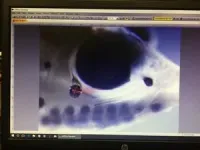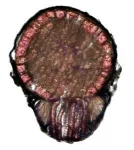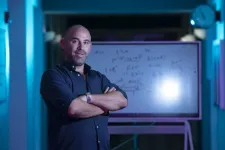(Press-News.org) Los Angeles (February –, 2025)—Evolving roughly 27 different times in the long history of fish, bioluminescence—the biological production of light—is one of the flashier survival tools used for luring prey, communication, and recognizing potential mates among various species. In a new study published in Ichthyological Research, an international team of researchers studied the organs that produce light in Vinciguerria mabahiss, a rare species of fish from the Red Sea. This paper marks the first-ever close examination of these organs, providing key information on their structure and how V. mabahiss uses bioluminescence to make its way through the water—and laying the foundational groundwork for future scientists studying fish bioluminescence.
“There are a lot of different ways that fish go about producing and using light,” says lead author Dr. Todd Clardy, Collections Manager of Ichthyology at the Natural History Museum of Los Angeles County. “One of the things that we wanted to do was find out how this species of fish was using the light it produced. And part of that was by examining the structure of the photophore and not just how they looked at the cellular level, but we examined the size and the distribution of them across the body of the fish to try to assess what this fish was doing with these cool photophore organs, and it turns out they're using it as counter illumination.”
While most of us might think of bioluminescence as an attractor—picture anglerfish luring prey with light in the depths—Clardy and his teammates found that V. mabahiss used its light to hide. Counter illumination is a kind of camouflage where an animal produces lights to make itself harder to be seen by predators.
“We live in basically a two-dimensional world”, says Clardy. “I never think to look for a cheeseburger up above me. But fish are always looking up for a shadow passing over them because it’s either going to be food or a predator.” Counter illumination breaks up that shadow to mimic the light of the surface. “The fish is camouflaged, almost invisible.”
Clardy and his team found that V. mabahiss have between 140 and 144 photophores of varying sizes throughout their bodies, all pointed downwards. Each photophore produces a blue light, breaking up the silhouette of the fish and camouflaging them from any predator looking up. They looked at five juvenile V. mabahiss specimens to better understand how the fish used its light.
While the photophores varied in size, the researchers found that they all shared the same structure. The light is produced through a well-understood bacterial reaction, and the sophisticated composition of the photophores directs that bioluminescence into useful camouflage. “They have this thick pigment layer to block the light from entering the fish, reflective cells that amplify the light, and a lens that lets the light pass through,” says Clardy.
A small fish only known to the Red Sea, V. mabahiss lives deep underwater and is seldom encountered by people, so much so that it has no common name. The findings from this study will provide bedrock information for future researchers to study bioluminescence in fish. “Its rarity means that V. mabahiss may be difficult to collect for most researchers,” says Clardy “We hope to provide information that other scientists can use for the broader study of bioluminescence.”
END
New study shines a light on the mechanics of bioluminescence in the rare fish Vinciguerria mabahiss
2025-03-26
ELSE PRESS RELEASES FROM THIS DATE:
Getting hit by lightning is good for some tropical trees
2025-03-26
Getting zapped with millions of volts of electricity may not sound like a healthy activity, but for some trees, it is. A new study, published in New Phytologist, reports that some tropical tree species are not only able to tolerate lightning strikes, but benefit from them. The trees may have even evolved to act as lightning rods.
The research was led by Evan Gora, a forest ecologist at Cary Institute of Ecosystem Studies. Gora studies how lightning impacts biodiversity and carbon storage in Panama’s tropical forests.
Lightning kills hundreds of millions of trees per year. But in 2015, while working in Panama, Gora and his colleagues came across ...
Soldiers can cope with killing
2025-03-26
Taking a person’s life is not automatically harmful to a soldier’s mental well-being if the circumstances justified it, according to a study of more than 14,600 soldiers.
“Killing another person does not in itself seem to be something that goes against human nature, and it doesn’t necessarily harm the mental health of the person who does it,” said Andreas Espetvedt Nordstrand, a Norwegian clinical psychologist.
Commander Nordstrand is the head of research and development at the Institute of Military Psychiatry, Norwegian Armed Forces – Joint ...
Quantum Leap: NIST selects FAU for new generation of encryption standards
2025-03-26
The National Institute of Standards and Technology (NIST) has selected Florida Atlantic University’s Hamming Quasi-Cyclic (HQC) for standardization in its Post-Quantum Cryptography (PQC) project. After a thorough evaluation process, NIST selected HQC to be part of the new generation of encryption standards, for its ability to meet its criteria for security, efficiency and practical implementation.
HQC is a cryptographic algorithm designed to ensure secure key exchange between two parties, enabling ...
City of Hope-led study demystifies tumor formation’s two-step process — a foundational understanding needed to prevent cancer
2025-03-26
LOS ANGELES — Researchers at City of Hope®, one of the largest and most advanced cancer research and treatment organizations in the U.S. with its National Medical Center named top 5 in the nation for cancer by U.S. News & World Report, have found that cell mutations are necessary but not always sufficient for tumors to form. Instead, they suggest that additional risk factors that promote tumor growth, like chronic inflammation, are a key trigger for tumor formation.
The study findings, published this month in Cancer Discovery, answer a question that scientists have long asked: Are cell mutations alone ...
We are vastly overestimating the amount of fresh water available for lithium mining, new study finds
2025-03-26
March 26, 2025
We Are Vastly Overestimating the Amount of Fresh Water Available for Lithium Mining, New Study Finds
New research led by UMass Amherst hydrologists sounds the alarm over mining practices that have immediate implications for transition to low-carbon economy
AMHERST, Mass. — New research into lithium mining in the “Lithium Triangle” of Chile, Argentina and Bolivia — source of more than half of the world’s lithium resources — shows that the commonly accepted models used ...
If native plants are going to survive climate change, they need our help to move—here’s how to do it safely
2025-03-26
March 26, 2025
AMHERST, Mass. – Many native plants in the U.S. cannot possibly move themselves fast enough to avoid climate-change driven extinction. If these native plants are going to have any chance of surviving into the future, they’ll need human help to move into adjacent areas, a process known as “managed relocation.” And yet, there’s no guarantee that a plant will thrive in a new area. Furthermore, movement of introduced plants, albeit over much larger distances, is exactly how the problem of invasive species began—think of kudzu-choked forests, wetlands taken over by purple ...
Blue pigment improves foundation makeup shades for dark skin
2025-03-26
SAN DIEGO, March 26, 2025 — On the shelves of makeup counters and drugstores sits an array of foundations in various olive, ivory and fair shades. But for people with darker skin tones, finding the right foundation shade can be a challenge. Dark foundations on the market often fall flat, appearing gray-like once applied on the skin. But now, researchers report a blue cosmetic color additive that gives these foundations the warmth and depth they currently lack.
Gabriella Baki, associate professor of pharmaceutics and director of the cosmetic science and formulation design undergraduate program at the University of ...
A safe nuclear battery that could last a lifetime
2025-03-26
SAN DIEGO, March 26, 2025 — Sometimes cell phones die sooner than expected or electric vehicles don’t have enough charge to reach their destination. The rechargeable lithium-ion (Li-ion) batteries in these and other devices typically last hours or days between charging. However, with repeated use, batteries degrade and need to be recharged more frequently. Now, researchers are considering radiocarbon as a source for safe, small and affordable nuclear batteries that could last decades or longer without charging.
Su-Il In, a professor at Daegu Gyeongbuk Institute of Science & Technology, will present his results at the spring meeting of the American Chemical ...
Making sturdy, semi-transparent wood with cheap, natural materials
2025-03-26
SAN DIEGO, March 26, 2025 — Can you imagine a smartphone with a wooden touchscreen? Or a house with wooden windows? Probably not — unless you’ve heard of transparent wood. Made by modifying wood’s natural structure, this material has been proposed as a sturdy, eco-friendly plastic alternative. But wood’s biodegradability is often sacrificed in the process. Researchers are hoping to change that by creating transparent woods from almost entirely natural materials and making them electrically conductive.
The researchers will present their results at the spring ...
Adulting is hard on the heart: Teen to young adulthood is a critical time to address risk
2025-03-26
Statement Highlights:
By age 18, many adolescents have already developed heart disease risk factors, such as high blood pressure, obesity, high cholesterol or Type 2 diabetes, and a growing number of younger adults are experiencing adverse cardiovascular events.
Numerous social determinants of health and developmental and life changes impact cardiovascular risk as young people progress from their teens to their mid-20s.
The statement describes the challenges and opportunities for easing the transition ...










